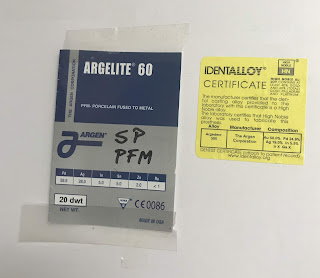How to fit a crown in 2019?
I wrote a post in 2013 "Why are my crowns not fitting?" that was pretty clear in it's explanations, but that was 6 years ago. I don't do it much differently now but there are a few changes especially because of the different types of crowns that I am inserting.
Emax (lithium disilicate) and Zirconium crowns are pretty easy to fit, assuming you start by giving the laboratory a good preparation and a clear impression that captures the entire preparation, including the full extent of the finishing line ( the crowns margin is supposed to end here). Preparations should not be too subgingival and the margin must be visible when taking an impression, whether an elastomeric or optical impression is taken.
Once one of these crowns is fabricated, fitting should be relatively easy. First there can be no gingival tissue impinging on the margin and if it is than either it should be curetted off or retraction chord should be placed to keep it away from the margin. Care should be taken to carefully remove all temporary cement from the preparation to insure an intimate fit for the crown since little bits of leftover temporary cement can prevent full seating of all ceramic and zirconium restorations.
The next thing to check is the tightness of the interproximal contacts on both sides. I seat the crown and then use unwaxed Johnson and Johnson floss to test my contacts. I start with the mesial contact and see if the floss goes through without breaking or shredding. I don't use waxed floss for this first step because it will often go through even overly tight contacts. This step is important because one of the common reasons even good fitting crowns won't seat is a overly tight contact.
If my contact is tight , I dry the crown and place Accufilm IV liquid on the proximal contact surface of the crown. Once it drys, I reseat the crown and remove it and inspect the contact to see where the blue ink has been rubbed off. If I don't have access to this product ( when I am teaching at the dental school) I use a piece of Accuflim marking paper placed around the adjacent tooth when seating the crown. Either way I am able to visualize the place where I need to adjust my contact using a medium grit small greenstone wheel. I can do this repeatedly until my contact allows the unwaxed floss to pass through properly. At that point the contact is polished with a Brasseler grey wheel that has diamond impregnated in rubber. After the mesial contact is done I will proceed to chect the distal contact. Often a tight mesial contact will cause the distal to be tight as well, but when the mesial contact is corrected the distal will be less tight as well.
The last thing to check is the occlusion. Although we dentists like to ask the patient to tell us whether the bite is good, it's not the best way to check, since they are numb and have difficulty judging the bite. Instead I try in the crown and ask them to bite. Then I remove the crown and ask them if their bite is better. I ask them to pay special attention to how the side of their mouth feels that is not numb, since this should still feel normal. Sometimes I have to run through this routine multiple times but eventually most patients can be taught to judge when the "bite" is correct using this technique.
Of course I use marking paper to mark the occlusion and take care to dry the crown before doing so. Often I ask the patient to bite down and clench with moderate pressure and while they are closed I tug laterally on the paper, since this seems to ensure that the paper leave a noticeable mark.
After I have checked the bite in normal occlusion, I also check it in lateral excursions, since if these contacts are high it can cause a porcelain fracture in the future since people's teeth contact in many positions when they are eating.
Porcelain fused to metal crowns are often more difficult to fit since they are made with a lost wax technique and often the die can become abraded since wax will spring undercuts but the metal casting will not. When fitting a pfm crown , after I adjust my contacts I use GC fit checker to check for undesirable internal binding spots and to check for an intimate fit. If there are internal "drag" marks noticed , I relieve them using a small round bur at low speed. If I find that I need to relieve my internal casting I will repeat the application of fit checker until I am happy with the fit. An acceptable fit is one in which there is a thin uniform layer of fit checker along the margin of my casting. Ideally the thickness should be thin enough the the fit checker is translucent and allows the dentist to see the grey of the casting through the silicone fit checker.
The final step, performed immediately prior to cementation, is to take a bitewing radiograph of the seated crown. I check that the crown covers my entire finish line and that there is no visible gap between the crown and the tooth. If the radiograph looks good I will then cement my patients crown.
Although this process can take additional time, I find that it help ensure that my crowns fit well and once inserted, hopefully my patient will enjoy many years of service from their new restoration.
from Ask Dr. Spindel - http://lspindelnycdds.blogspot.com/2019/07/how-to-fit-crown-in-2019.html - http://lspindelnycdds.blogspot.com/


Comments
Post a Comment